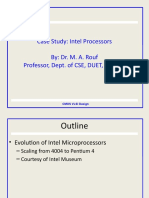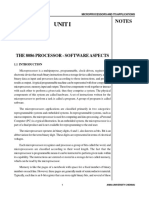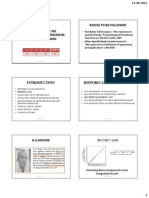Lecture-1
Course Code: 520225
(Microprocessor and Assembly
Language Programming)
Introduction
to
Microprocessor
Case Study: Intel Processors CMOS VLSI Design Slide 2
Definition
❑ A microprocessor is a multipurpose, programmable,
clock-driven, register-based electronic device
❑ That reads binary instructions from a storage device
called memory
❑ accepts binary data as input and processes data
according to instructions, and provides result as
output.
Case Study: Intel Processors CMOS VLSI Design Slide 3
Definition
❑ A microprocessor consists of multiple internal
function units.
❑ A basic design has an arithmetic logic unit (ALU), a
control unit, a memory interface, an interrupt or
exception controller, and an internal cache.
❑ More sophisticated microprocessors might also
contain extra units that assist in floating-point match
calculations, program branching, or vector
processing.
Case Study: Intel Processors CMOS VLSI Design Slide 4
Microprocessor
Case Study: Intel Processors CMOS VLSI Design Slide 5
Evolution of Intel Microprocessors
❑ Evolution of Intel Microprocessors
– Scaling from 4004 to Pentium 4
– Fairchild Semiconductors (founded in 1957) invented the
first IC in 1959.
– In 1968, Robert Noyce, Gordan Moore, Andrew Grove
resigned from Fairchild Semiconductors.
– They founded their own company Intel (Integrated
Electronics).
– Intel grown from 3 man start-up in 1968 to industrial giant
by 1981.
– It had 20,000 employees and $188 million revenue.
Case Study: Intel Processors CMOS VLSI Design Slide 6
4004
❑ First microprocessor (1971)
– For Busicom calculator
❑ Characteristics
– 10 μm process
– 2300 transistors
– 400 – 800 kHz
– 4-bit word size
– 16-pin DIP package
❑ Masks hand cut from Rubylith
– Drawn with color pencils
– 1 metal, 1 poly (jumpers)
– Diagonal lines (!)
Case Study: Intel Processors CMOS VLSI Design Slide 7
8008
❑ 8-bit follow-on (1972)
– Dumb terminals
❑ Characteristics
– 10 μm process
– 3500 transistors
– 500 – 800 kHz
– 8-bit word size
– 18-pin DIP package
❑ Note 8-bit datapaths
– Individual transistors visible
Case Study: Intel Processors CMOS VLSI Design Slide 8
8080
❑ 16-bit address bus (1974)
– Used in Altair computer
• (early hobbyist PC)
❑ Characteristics
– 6 μm process
– 4500 transistors
– 2 MHz
– 8-bit word size
– 40-pin DIP package
Case Study: Intel Processors CMOS VLSI Design Slide 9
8086 / 8088
❑ 16-bit processor (1978-9)
– IBM PC and PC XT
– Revolutionary products
– Introduced x86 ISA
❑ Characteristics
– 3 μm process
– 29k transistors
– 5-10 MHz
– 16-bit word size
– 40-pin DIP package
❑ Microcode ROM
Case Study: Intel Processors CMOS VLSI Design Slide 10
80286
❑ Virtual memory (1982)
– IBM PC AT
❑ Characteristics
– 1.5 μm process
– 134k transistors
– 6-12 MHz
– 16-bit word size
– 68-pin PGA
❑ Regular datapaths and
ROMs
Bitslices clearly visible
Case Study: Intel Processors CMOS VLSI Design Slide 11
80386
❑ 32-bit processor (1985)
– Modern x86 ISA
❑ Characteristics
– 1.5-1 μm process
– 275k transistors
– 16-33 MHz
– 32-bit word size
– 100-pin PGA
❑ 32-bit datapath,
microcode ROM,
synthesized control
Case Study: Intel Processors CMOS VLSI Design Slide 12
80486
❑ Pipelining (1989)
– Floating point unit
– 8 KB cache
❑ Characteristics
– 1-0.6 μm process
– 1.2M transistors
– 25-100 MHz
– 32-bit word size
– 168-pin PGA
❑ Cache, Integer datapath,
FPU, microcode,
synthesized control
Case Study: Intel Processors CMOS VLSI Design Slide 13
Pentium
❑ Superscalar (1993)
– 2 instructions per cycle
– Separate 8KB I$ & D$
❑ Characteristics
– 0.8-0.35 μm process
– 3.2M transistors
– 60-300 MHz
– 32-bit word size
– 296-pin PGA
❑ Caches, datapath,
FPU, control
Case Study: Intel Processors CMOS VLSI Design Slide 14
Pentium Pro / II / III
❑ Dynamic execution (1995-9)
– 3 micro-ops / cycle
– Out of order execution
– 16-32 KB I$ & D$
– Multimedia instructions
– PIII adds 256+ KB L2$
❑ Characteristics
– 0.6-0.18 μm process
– 5.5M-28M transistors
– 166-1000 MHz
– 32-bit word size
– MCM / SECC
Case Study: Intel Processors CMOS VLSI Design Slide 15
Pentium 4
❑ Deep pipeline (2001)
– Very fast clock
– 256-1024 KB L2$
❑ Characteristics
– 180 – 90 nm process
– 42-125M transistors
– 1.4-3.4 GHz
– 32-bit word size
– 478-pin PGA
❑ Units start to become
invisible on this scale
Case Study: Intel Processors CMOS VLSI Design Slide 16
Summary
❑ 104 increase in transistor count, clock frequency
over 30 years!
Case Study: Intel Processors CMOS VLSI Design Slide 17
Moore’s Law
❑ In 1965, one of the founders of Intel – Gordon Moore –
predicted that “The number of transistor on an IC (and
therefore the capability of microprocessors) will double
every year. Later he modified it to 18-months”
❑ His prediction still holds true in ‘13. In fact, the time
required for doubling is contracting to the original
prediction, and is closer to a year now.
Case Study: Intel Processors CMOS VLSI Design Slide 18
Evolution of Intel Microprocessors
Case Study: Intel Processors CMOS VLSI Design Slide 19
Thank You
Case Study: Intel Processors CMOS VLSI Design Slide 20




















































































